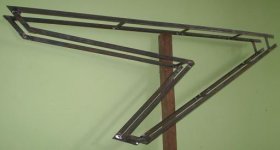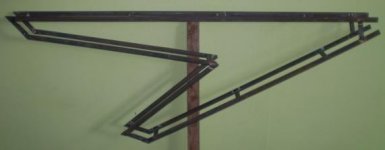John in CR
100 TW
While I bide my time before dry season gets in full swing and I try some high speed runs, it's time to get busy building some ebikes. I want to do some stuff more presentable. I won't chase an AJ type finish, but it's time to end the ugly experiments. I figure if I do a build log, then I'm committed to getting it finished in short order.
Where to put the batteries? Inside the bike, of course. Sure some guys have built some bikes that fit some batteries, but I like big capacity packs for better battery life. My Konions have lost some capacity but are still going strong after 23 months of daily use, so big capacity packs work. I'm way over the manufacturer's rated cycle life, and I started with used cells. To meet my needs I don't need a bike with a battery compartment, I need a bike that has a battery cavern!
Here's a quick drawing of my general idea.

I'm not ready for a carbon fiber build, because I don't know enough to be confident about the critical stress areas, so my materials will be steel, balsa wood, 3mm plywood, fiberglass, and epoxy. I'm using 3/4"x1/8" and 1/2"x1/8" flat steel with lots of triangulation for strength in the plane of the bike, with double thickness at the high stress points at the headset, BB, and rear suspension. 2 flat steel skeletons will create the shape in the drawing above. Thick epoxy impregnated balsa will go around the perimeter for longitudinal rigidity. 3mm ply will go on the sides as side covers with fiberglass bonding it to the steel. Access to the inside will be through the rear, which will bolt on. The rest will be permanently attached. The balsa and plywood will make smooth shaping and finishing a breeze. Overall, it should be a fairly lightweight frame.
The length at what would be the top tube on a normal bike is 55". The width open on the inside will be just under 4", so 3 wide A123 M1 26650 cells or 4 wide 18650 Konions will fit with room for padding and securing the packs. To give you an idea of how much space I have to work with, I can fit 1.2wkh of Konion cells just in the first 2.75" of height along the top, and that's with lots of room to spare. I should be able to fit 3kwh or more of batteries inside the bike if I want.
Where to put the batteries? Inside the bike, of course. Sure some guys have built some bikes that fit some batteries, but I like big capacity packs for better battery life. My Konions have lost some capacity but are still going strong after 23 months of daily use, so big capacity packs work. I'm way over the manufacturer's rated cycle life, and I started with used cells. To meet my needs I don't need a bike with a battery compartment, I need a bike that has a battery cavern!
Here's a quick drawing of my general idea.

I'm not ready for a carbon fiber build, because I don't know enough to be confident about the critical stress areas, so my materials will be steel, balsa wood, 3mm plywood, fiberglass, and epoxy. I'm using 3/4"x1/8" and 1/2"x1/8" flat steel with lots of triangulation for strength in the plane of the bike, with double thickness at the high stress points at the headset, BB, and rear suspension. 2 flat steel skeletons will create the shape in the drawing above. Thick epoxy impregnated balsa will go around the perimeter for longitudinal rigidity. 3mm ply will go on the sides as side covers with fiberglass bonding it to the steel. Access to the inside will be through the rear, which will bolt on. The rest will be permanently attached. The balsa and plywood will make smooth shaping and finishing a breeze. Overall, it should be a fairly lightweight frame.
The length at what would be the top tube on a normal bike is 55". The width open on the inside will be just under 4", so 3 wide A123 M1 26650 cells or 4 wide 18650 Konions will fit with room for padding and securing the packs. To give you an idea of how much space I have to work with, I can fit 1.2wkh of Konion cells just in the first 2.75" of height along the top, and that's with lots of room to spare. I should be able to fit 3kwh or more of batteries inside the bike if I want.






